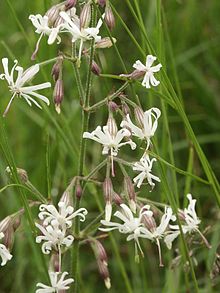Silene nutans
| Silene nutans | |
|---|---|

| |
| Scientific classification | |
| Kingdom: | Plantae |
| Clade: | Tracheophytes |
| Clade: | Angiosperms |
| Clade: | Eudicots |
| Order: | Caryophyllales |
| Family: | Caryophyllaceae |
| Genus: | Silene |
| Species: | S. nutans
|
| Binomial name | |
| Silene nutans | |
| Synonyms [2] | |
| |
Silene nutans is a flowering plant in the genus Silene, most commonly known as Nottingham catchfly.[3]
Description[edit]
Silene nutans is a diploid, mainly outcrossing, herbaceous, perennial plant.[4] It grows up to 25–80 centimetres (10–31 in) tall, from a branching, woody stock with a thick taproot.[5] The lower leaves are up to 75 millimetres (3 in) long, spathulate and have a long stalk, while leaves higher on the plant are lanceolate, subsessile and acute; all the leaves are covered in soft hairs.[5] The flowers are 18 millimetres (0.7 in) wide, 12 millimetres (0.5 in) long, and drooping, on short, viscid stalks. The petals are white or pinkish and divided into two narrow lobes. Each flower remains open for three nights as a means of preventing self-fertilisation; the flower reveals one whorl of stamens on the first night, the second whorl of stamens on the second night, and the three styles on the third night.[5] The seeds are 10–22 millimetres (0.4–0.9 in) wide and kidney-shaped.[5]
Distribution[edit]
Silene nutans is widespread across Europe, from southern Spain and Italy north to the British Isles and Scandinavia, and is also found across large parts of Asia.[2] It has been introduced to North America, where it is known as the Eurasian catchfly. It is found in the U.S. states of Michigan, Ohio, New York, Vermont and Maine.[6]
Silene nutans can sometimes be found in the very widespread MG1 (Arrhenatherum elatius grassland) community of the British National Vegetation Classification, and thus can be found where Arrhenatherum elatius (false oat grass) or Dactylis glomerata (cocksfoot) occur.[7]
Ecology[edit]
Silene nutans is a steppe species across most of its range. At the periphery of its distribution, it has a patchy distribution in xeric habitats, such as open grasslands and on rock outcrops at forest margins, on both acidic and alkaline substrates (pH 3.8–8.0).[4] In the far north of its range, S. nutans is characteristic of maritime cliffs.[8]
Silene nutans flowers during the night, and produces a strong floral scent to attract its pollinators, which are mostly night-flying moths. Chemical compounds in the scent include benzyl acetate and benzaldehyde.[9]
Silene nutans is the host plant for the leaf mining moth Coleophora galbulipennella.[10]
Nottingham[edit]
The common name Nottingham catchfly commemorates the former occurrence of S. nutans on the walls of Nottingham Castle,[11] and the species was chosen to represent the unitary authority of Nottingham as its county flower.[12] Despite this association, Nottingham catchflies no longer occur in either the city of Nottingham[13] or the wider county of Nottinghamshire.[14]
Nottingham Castle Trust asked volunteers to grow the plant from seeds supplied to donate the successful plants back to the City to commemorate the re-opening of the renovation of Nottingham Castle.[15]
References[edit]
- ^ "Silene nutans". Integrated Taxonomic Information System.
- ^ a b Jaakko Jalas & Juha Suominen, ed. (1988). Atlas florae Europaeae: distribution of vascular plants in Europe, Volume 3. Cambridge University Press. p. 416. ISBN 978-0-521-34272-8.
- ^ BSBI List 2007 (xls). Botanical Society of Britain and Ireland. Archived from the original (xls) on 2015-06-26. Retrieved 2014-10-17.
- ^ a b Fabienne van Rossum, Xavier Vekemans, Pierre Meerts, Emmanuelle Gratia & Claude Lefèbvre (1997). "Allozyme variation in relation to ecotypic differentiation and population size in marginal populations of Silene nutans". Heredity. 78 (5): 552–560. doi:10.1038/hdy.1997.86.
{{cite journal}}: CS1 maint: multiple names: authors list (link) - ^ a b c d "Silene nutans". Ecological Flora of the British Isles. Retrieved January 12, 2010.
- ^ USDA, NRCS (n.d.). "'Silene nutans L. (Eurasian catchfly)". The PLANTS Database (plants.usda.gov). Greensboro, North Carolina: National Plant Data Team. Retrieved January 12, 2010.
- ^ John S. Rodwell (1992). Volume 3 - Grasslands and montane communities. British Plant Communities. ISBN 978-0-521-39166-5.
- ^ Catherine A. G. Lloyd (ed.). "Maritime Cliff and Slope CE2" (PDF). Tayside Local Biodiversity Action Plan. Angus Council. Retrieved January 12, 2010.
- ^ A. Jürgens, T. Witt & G. Gottsberger (2002). "Flower scent composition in night-flowering Silene species (Caryophyllaceae)". Biochemical Systematics and Ecology. 30 (5): 383–397. doi:10.1016/S0305-1978(01)00106-5.
- ^ "551 Coleophora galbulipennella (Zeller,1858)". British Leafminers. Retrieved January 12, 2010.
- ^ Henry Hurd Swinnerton (1910). "8. Natural History". Nottinghamshire. Cambridge County Geographies.
- ^ Plantlife website County Flowers page Archived 2015-04-30 at the Wayback Machine
- ^ "The floral emblem of your county". Daily Telegraph. May 5, 2004.
- ^ "Biodiversity". Nottinghamshire County Council. Retrieved January 12, 2010.
- ^ "Nottingham Catchfly: The Project So Far". 3 March 2021.
External links[edit]
- Root system sketch of Silene nutans, at Wageningen University and Research
